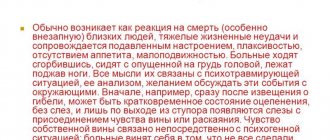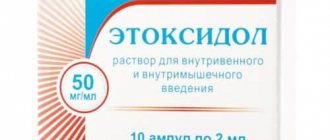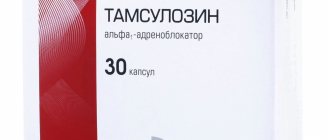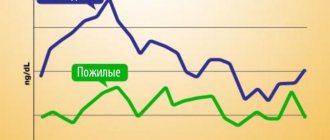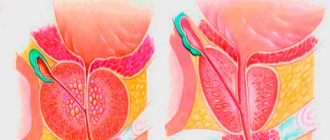general information
Artezin belongs to the group of alpha-blockers. Its INN is Doxazosin. The name comes from the active ingredient included in its composition. This substance has a vasodilating effect, which is useful for high blood pressure. It also suppresses the symptoms of prostatitis and prevents the enlargement of the prostate gland. It is used in the field of urology and cardiovascular diseases.
Release form, price
The Russian-made drug is available in tablet form. Tablets contain 2 or 4 mg of the active substance doxazosin. They are round, white with a cream tint, and flat-cylindrical. They are placed in blisters of 10 pieces. The package contains 3 blisters. The cost of the medicine is indicated in the table (Table 1).
Table 1 - Cost of Artesin
| Quantity | Active substance content | Price |
| 30 pcs. | 2 mg | 375 rub. |
| 30 pcs. | 4 mg | 465 rub. |
These release forms differ only in the content of the active substance. All their other characteristics are the same.
Compound
In addition to doxazosin, Artesin contains excipients. These include:
- lactose;
- microcrystalline cellulose;
- magnesium stearate;
- potato starch;
- povidone;
- sodium lauryl sulfate;
- colloidal silicon dioxide.
All these components are present in both forms of the drug. They allow you to give the medicine the required form and ensure the implementation of its functions.
Pharmacodynamics and pharmacokinetics
Under the influence of doxazosin, the muscle tone of blood vessels weakens, resulting in a decrease in blood pressure. This occurs 2-6 hours after taking the drug. The effect lasts for about a day. The medicine has a positive effect on metabolism, which makes it effective for treating patients with diabetes and excess weight. The drug can reduce cholesterol and triglyceride levels in the blood.
Due to the fact that Artesin dilates blood vessels, the likelihood of developing heart disease is reduced. Blood circulates faster throughout the body, providing oxygen to organs, which has a positive effect on the heart.
Long-term use of the drug does not lead to a decrease in sensitivity to the active substance. When using the medicine by people with normal blood pressure, their health does not worsen. The drug causes a decrease in blood pressure only in hypertensive patients.
Characteristics of Artesin
Doxazosin also acts on the prostate gland and bladder. Under its influence, the resistance of the sphincter and urethra is neutralized, thereby eliminating the unfavorable symptoms caused by BPH. Improvements become noticeable after 2 weeks of continuous use.
The absorption of the drug occurs in the digestive tract. When taken internally, it reaches its maximum effect after 3-5 hours. Taking tablets with food reduces the rate of absorption. The potential for doxazosin to bind to blood proteins is very high. When absorbed, the substance forms metabolites.
It is excreted through the intestines, only a small part leaves the body with urine. It takes 19-22 hours to eliminate half of the incoming medicine from the body. Therefore, it is advisable to take the prescribed number of tablets at a time, rather than dividing them into several doses.
Indications, contraindications
The medicine should be taken as directed by a doctor and if indicated. This is done in the following cases:
- arterial hypertension;
- BPH (with normal and high blood pressure).
Artesin for these pathologies is taken together with other drugs or separately from them. A specialist determines how to act in each situation.
BPH
Sometimes taking this drug is prohibited due to certain characteristics of the patient. This:
- age less than 18 years;
- intolerance to doxosazine;
- hypersensitivity to other components of the drug.
These features are among the strict contraindications. In addition to these, there are restrictions. These include:
- liver diseases;
- mitral stenosis;
- orthostatic hypertension;
- aortic stenosis;
- pregnancy and natural feeding.
Aortic stenosis
In these cases, the use of Artezin is not prohibited. A doctor can prescribe this remedy if necessary. But he must monitor the treatment process, and the patient should inform the specialist about all detected changes in the body, both positive and negative.
Instructions:
Clinical and pharmacological group
01.008 (Alpha1-adrenergic blocker. Antihypertensive drug. Drug used for urinary disorders in benign prostatic hyperplasia)
Release form, composition and packaging
Tablets are white or white with a creamy tint, flat-cylindrical with a bevel.
| 1 tab. | |
| doxazosin mesylate | 1.22 mg, |
| which corresponds to the content of doxazosin | 1 mg |
Excipients: potato starch, lactose, microcrystalline cellulose, povidone (kollidon 25), colloidal silicon dioxide (aerosil), sodium lauryl sulfate, magnesium stearate.
10 pieces. — cellular contour packages (3) — cardboard packs.
Tablets are white or off-white with a creamy tint, flat-cylindrical in shape.
| 1 tab. | |
| doxazosin mesylate | 2.44 mg, |
| which corresponds to the content of doxazosin | 2 mg |
Excipients: potato starch, lactose, microcrystalline cellulose, povidone, colloidal silicon dioxide (Aerosil), sodium lauryl sulfate (sodium dodecyl sulfate), magnesium stearate.
10 pieces. — cellular contour packages (3) — cardboard packs.
Tablets are white or off-white with a creamy tint, flat-cylindrical in shape.
| 1 tab. | |
| doxazosin mesylate | 4.88 mg, |
| which corresponds to the content of doxazosin | 4 mg |
Excipients: potato starch, lactose, povidone (kollidon 25), crospovidone (kollidon CL), magnesium stearate.
10 pieces. — cellular contour packages (3) — cardboard packs.
pharmachologic effect
Selective competitive blocker of postsynaptic α1-adrenergic receptors. By reducing vascular muscle tone, doxazosin reduces peripheral vascular resistance, which leads to a decrease in blood pressure.
After a single dose of the drug, the maximum decrease in blood pressure is observed within 2-6 hours. The hypotensive effect persists for 24 hours.
During treatment with Artezin® in patients with arterial hypertension, there are no differences in blood pressure values in the standing and lying positions. Effective for arterial hypertension, incl. accompanied by metabolic disorders (obesity, decreased glucose tolerance). Reduces the risk of developing coronary artery disease.
The use of the drug in patients with normal blood pressure is not accompanied by a decrease in blood pressure.
With long-term use of Artesin, patients do not experience a change in tolerance to the therapeutic antihypertensive effect.
During treatment with Artezin, a decrease in the level of triglycerides and total cholesterol in the blood plasma is observed. At the same time, there is an increase (by 4-13%) in the HDL/total cholesterol ratio.
With long-term use of the drug, regression of left ventricular hypertrophy, suppression of platelet aggregation and an increase in the content of active plasminogen in tissues are observed.
Due to the fact that doxazosin blocks α1-adrenergic receptors located in the stroma and capsule of the prostate gland and in the neck of the bladder, there is a decrease in resistance and pressure in the urethra, a decrease in the resistance of the internal sphincter, which in turn leads to a significant improvement in urodynamics and reducing symptoms of benign prostatic hyperplasia. The drug is effective in 66-71% of patients, a stable clinical effect develops after 1-2 weeks of treatment, maximum effect after 14 weeks. The effect lasts for a long time.
Pharmacokinetics
Suction and distribution
After oral administration in therapeutic doses, doxazosin is well absorbed from the gastrointestinal tract. Absorption - 80-90%. Simultaneous food intake slows down absorption by 1 hour. Time to reach Cmax is 3 hours, with evening intake - 5 hours. Bioavailability - 60-70% (due to first-pass metabolism).
Binding to blood plasma proteins is about 98%.
Metabolism
Rapidly metabolized in the liver by o-demethylation and hydroxylation.
Removal
Elimination from blood plasma occurs in 2 phases with a final T1/2 of 19-22 hours, which allows the drug to be prescribed once a day.
It is excreted through the intestines, mainly in the form of metabolites up to 65%, with urine - 5% (unchanged).
Pharmacokinetics in special clinical situations
Studies of the pharmacokinetics of doxazosin in elderly patients and in patients with kidney disease did not reveal significant pharmacokinetic differences.
Dosage
The drug is prescribed orally 1 time/day (morning or evening), regardless of food intake, without chewing and with a sufficient amount of water.
For arterial hypertension, the initial daily dose is 1 mg at bedtime.
After taking the first dose, the patient should remain in bed for 6-8 hours. This is necessary due to the possibility of developing the “first dose phenomenon,” especially against the background of previous use of diuretics.
If the therapeutic effect is insufficient, after 1-2 weeks the daily dose can be increased to 2 mg. Subsequently, every 1-2 weeks you can increase the dose by 2 mg. In most patients, the optimal therapeutic effect is achieved with a daily dose of 8 mg. The maximum daily dose is 16 mg.
After achieving a stable therapeutic effect, the dose is usually reduced (the average therapeutic dose for maintenance therapy is usually 2-4 mg/day).
For benign prostatic hyperplasia, Artesin® is prescribed at an initial dose of 1 mg/day. If necessary, the dose is increased to 2-4 mg/day. The maximum daily dose is 8 mg.
The duration of treatment is long and is determined by the attending physician.
Overdose
Symptoms: pronounced decrease in blood pressure, sometimes accompanied by fainting.
Treatment: the patient must be given a horizontal position with raised legs. Symptomatic therapy is carried out. Hemodialysis is ineffective.
Drug interactions
Doxazosin enhances the hypotensive effect of antihypertensive drugs (when used in combinations, dose adjustment is required).
No adverse interactions were observed with the simultaneous use of doxazosin and thiazide diuretics, furosemide, beta-blockers, slow calcium channel blockers, ACE inhibitors, antibiotics, oral hypoglycemic agents, indirect anticoagulants and uricosuric agents.
The drug does not affect the degree of binding of digoxin and phenytoin to plasma proteins.
When used simultaneously with inducers of microsomal oxidation enzymes in the liver, the effectiveness of doxazosin may decrease, and with inhibitors it may increase.
Cimetidine increases the AUC of doxazosin.
NSAIDs (especially indomethacin), estrogens and sympathomimetic agents may reduce the hypotensive effect of doxazosin.
By eliminating the alpha-adrenergic stimulating effects of epinephrine, doxazosin can lead to the development of tachycardia and arterial hypotension.
Caution should be exercised when used concomitantly with phosphodiesterase inhibitors (medicines for the treatment of erectile dysfunction), as the hypotensive effect may be enhanced in some patients.
Use during pregnancy and lactation
To date, there is not enough experience with the use of the drug Artezin® during pregnancy and breastfeeding in patients with arterial hypertension. Therefore, despite the absence of teratogenic and embryotoxic effects according to experimental studies, Artezin® can be prescribed during pregnancy and breastfeeding only after a careful assessment of the expected benefits of therapy for the mother and the possible risk to the fetus or infant.
Side effects
Arterial hypertension
In clinical studies, the most commonly observed condition, especially at the beginning of treatment, was orthostatic hypotension, which in rare cases can lead to syncope.
From the cardiovascular system: edema, fainting.
From the central nervous system and peripheral nervous system: dizziness, headache, drowsiness.
From the digestive system: nausea.
From the respiratory system: rhinitis.
General reactions: asthenia, fatigue, malaise.
The following side effects were also observed in patients with arterial hypertension (a cause-and-effect relationship with taking the drug has not been established): bradycardia, tachycardia, palpitations, chest pain, angina pectoris, myocardial infarction, cerebrovascular accident, arrhythmia.
Benign prostatic hyperplasia
Patients with benign prostatic hyperplasia have the same side effects as patients with hypertension, plus:
From the cardiovascular system: decreased blood pressure, orthostatic hypertension.
From the central nervous system and peripheral nervous system: dry mouth, priapism, hypoesthesia, paresthesia, tremor, impotence, insomnia, increased excitability.
From the endocrine system: gynecomastia.
From the digestive system: abdominal pain, constipation, diarrhea, dyspepsia, flatulence, loss of appetite, nausea, increased activity of liver transaminases, cholestasis, jaundice, hepatitis.
From the hematopoietic organs: leukopenia, purpura, thrombocytopenia.
From the musculoskeletal system: arthralgia, muscle cramps, muscle weakness, myalgia.
From the respiratory system: bronchospasm, cough, shortness of breath, nosebleeds.
Dermatological reactions: alopecia.
From the senses: blurred vision, tinnitus.
From the urinary system: dysuria, hematuria, urinary dysfunction, nocturia, polyuria, urinary incontinence.
Allergic reactions: skin rash, urticaria.
Other: back pain, feeling of heat (flushes of blood in the skin of the face).
Storage conditions and periods
List B. The drug should be stored in a dry place, protected from light and out of reach of children, at a temperature not exceeding 25°C. Shelf life: 3 years.
Indications
- arterial hypertension (both in monotherapy and in combination with other antihypertensive drugs /thiazide diuretics, beta-blockers, slow calcium channel blockers or ACE inhibitors/);
- benign prostatic hyperplasia (both in the presence of arterial hypertension and normal blood pressure).
Contraindications
- age up to 18 years (efficacy and safety have not been established) - for tablets 2 mg and 4 mg;
- hypersensitivity to doxazosin, quinazolone derivatives or other components of the drug.
The drug should be used with caution in aortic and mitral stenosis, orthostatic hypotension, liver dysfunction, in patients under 18 years of age (efficacy and safety have not been established) for 1 mg tablets.
special instructions
Particular caution should be exercised when prescribing the drug to patients with impaired liver function, especially in cases where drugs that can adversely affect liver function are simultaneously used. In cases of deterioration of the functional state of the liver, the drug should be discontinued.
In order to prevent orthostatic reactions, patients should avoid sudden and sudden changes in body position (moving from a lying position to a standing position).
Before starting therapy, it is necessary to exclude malignant prostate tumors.
The effect of the first dose is especially pronounced against the background of previous diuretic therapy and a sodium-restricted diet.
Drinking alcohol can increase unwanted reactions.
Impact on the ability to drive vehicles and operate machinery
Due to the fact that the drug is capable of causing orthostatic reactions at the beginning of treatment or during the period of increasing doses, it is advisable for patients to refrain from all potentially hazardous activities, in particular from driving vehicles and other vehicles and mechanisms.
Use for renal impairment
Studies of the pharmacokinetics of doxazosin in patients with kidney disease did not reveal significant pharmacokinetic differences.
Use for liver dysfunction
The drug should be used with caution in case of liver dysfunction.
Conditions for dispensing from pharmacies
The drug is available with a prescription.
Instructions for use of Artezin (2 and 4 mg)
The calculation of the dosage of the drug depends on the amount of the active component in the drug and the underlying pathology. Also, the doctor must take into account the individual characteristics of the patient.
For arterial hypertension
For high blood pressure, the medicine should be taken according to the instructions received from the doctor, since the dosage can vary significantly depending on the characteristics of the course and pathology. Initially, 1 mg of doxososin per day is prescribed. Use it internally, without first crushing the tablets.
Arterial hypertension: degrees and stages of development
It is allowed to take the medicine both before and after meals - this does not affect the effectiveness. It is advisable to take the tablets before bed. After taking the first portion of the medicine at the beginning of treatment, you should lie in bed for at least 6 hours, since an unusual body may react negatively to the effect of the drug.
In the absence of a pronounced effect from such treatment, the portion of Artezin can be doubled.
Further increases in the dose are made every 2 weeks (if necessary). You should not greatly increase the dose of the medicine. The maximum permissible increase at one time is 2 mg. Most patients are prescribed 8 mg of the drug per day. The highest dosage can be 16 mg. After stable results appear, the dose of the drug is gradually reduced to the one that provides the desired effect. Most often it is 2-4 mg.
For BPH
In this case, the medication is also taken orally, regardless of the time of meal. The initial dose of Artezin is 1 mg per day. If the expected results do not occur, the dose can be increased to 2-4 mg. The maximum amount for this disease is 8 mg. The duration of treatment is determined individually.
The drug can affect the patient's blood pressure if he has problems in this area. With normal blood pressure levels, the drug does not affect your well-being in any way, even with long-term use.
Before prescribing Artesin to a patient to eliminate the symptoms of prostate hyperplasia, the doctor must make sure that the disease is benign. If you have a malignant neoplasm, you should not use this medicine.
Side effects and precautions
Side effects can occur when taking any medicine. Artesin can also provoke them. Sometimes they appear at the beginning of therapy due to the fact that the body is not adapted to the effects of the drug. Then the unfavorable symptoms will disappear after some time. In other cases, side effects are due to intolerance to the drug. Then the pathological symptoms will increase and will disappear only when the drug is discontinued.
Side effects of Artezin include:
- severe decrease in pressure;
- dizziness;
weakness;- increased fatigue;
- headache;
- swelling;
- fainting;
- nausea;
- tachycardia;
- chest pain;
- arrhythmia;
- runny nose.
These features appear when using medications for hypertension. If it is used to treat prostate hyperplasia, the same symptoms may occur, plus:
- dry mouth;
- abdominal pain;
- increased gas formation;
- loss of appetite;
- jaundice;
- insomnia;
- increased excitability;
leukopenia;- convulsions;
- decreased libido levels;
- erectile disfunction;
- dyspnea;
- cough;
- urinary disturbance;
- bronchospasms;
- nosebleeds;
- skin rashes;
- alopecia;
- noise in ears;
- visual disturbances.
Having discovered these and other abnormalities, the patient should consult with the attending physician. Artesin may need to be replaced with another product.
Consumption of Artesin in large doses can lead to a severe decrease in blood pressure. Against this background, a person may lose consciousness. Dizziness, weakness, drowsiness, and nausea may also be present.
Pathological manifestations can be eliminated using gastric lavage and symptomatic therapy, in particular, taking enterosorbents (Atoxil, Enterosgel). It is also advisable to take measures to prevent negative reactions from the cardiovascular system. Hemodialysis is not used because it does not give the desired results.
If necessary, Artezin can be used in combination with other medications. But you need to take into account that some of them can strengthen or weaken its effect. These include the following:
- Hypotensive.
- Sympathomimetics.
- Estrogen.
- NSAIDs.
- Indomethacin.
- Cimetidine.
It is not prohibited to use the drug together with them, but dose adjustment may be required. Therefore, the patient must inform the doctor about all the medications he is using.
Analogs
If there are contraindications, there is a need to use similar means. In this case, both structural analogs can be used - drugs with an identical composition, as well as drugs that have a different active component but a similar principle of action.
Structural
Completely identical drugs include:
Doxazosin. A medicine based on the substance of the same name, doxazosin. It dilates blood vessels and reduces pressure, relieves spasms. The drug is suitable for the treatment of arterial hypertension and prostate hyperplasia. Doxazosin is available in tablet form. Its cost depends on the number of tablets in the package and varies from 120 to 300 rubles.- Zoxon. It is also based on doxazosin. This drug is sold in tablet form and is used to treat hypertension. It is also prescribed for prostate enlargement. Its price is affected by the number of tablets in the pack and the content of the active substance in each of them. It is in the range of 200-900 rubles.
- Cardura. The active ingredient is doxazosin. The drug dilates blood vessels and helps lower blood pressure. It is produced in tablets. Packaging Kardura costs 400-700 rubles.
- Kamiren. The drug dilates blood vessels and fights high blood pressure. It is also effectively used in the complex treatment of prostate hyperplasia. The price for it ranges from 200 to 600 rubles.
Tonocardin. The drug is also used for prostate enlargement and high blood pressure. Its cost is 300-500 rubles.- Jenocard. The product is available in tablets of different dosages - 1, 2, 4 and 8 mg. Do not use it if you are intolerant to the composition. Its price is affected by the number of tablets in the package and the content of the active component in them. It can range from 360 to 830 rubles.
They have the same properties as the drug in question. Differences are possible only in the auxiliary components and dosage of the active component.
Drugs with similar effects
These medications differ from Artezin in composition, but are similar in their effect on the body. This:
- Setegis. Its active ingredient is terazosin. The product goes on sale in tablets. Belongs to the group of alpha-blockers and has a vasodilating effect. Setegis is used for hypertension and prostate enlargement.
Its use in children, people with low blood pressure and those intolerant to the composition is not allowed. For a package of medicine you will have to pay 650-1300 rubles, depending on the amount of terazosin in the composition.
Ebrantil. The main component of the drug is urapidil. Ebrantil exists in the form of capsules and solution. It has a hypotensive effect. Suitable for treating severe hypertension and overcoming hypertensive crises. You should not use it without a doctor's prescription, as it has many contraindications. Cost of the medicine: 700-1000 rubles. – solution, 250-340 rub. – capsules.- Urapidil. Its active ingredient is urapidil. The drug exists in the form of capsules and injection solution for intravenous administration. It is intended to lower blood pressure and is often used for hypertensive crises. Its use is contraindicated for children and pregnant women. When prescribing it to older people, caution is required. Urapidil costs from 950 to 1200 rubles.
Artesin
Active substance:
Doxazosin*
Pharmgroup:
Alpha blockers
Average price in pharmacies
| Name | Manufacturer | average price |
| Artesin 0.002 n30 tablet | VALENTA PHARMACEUTICS | 358.00 |
Analogs for the active substance:Doxazosin Doxazosin Belupo Doxazosin Sandoz Doxazosin-ratiopharm Doxazosin mesylate Zoxon Kamiren Kamiren HL Cardura Tonocardin Urocard | Application area:Prostate adenoma BPH Vasorenal hypertension Sudden increase in blood pressure Sudden increase in blood pressure Hypertensive circulatory disorder Hypertensive circulatory disorder Hypertensive state Hypertensive state Hypertensive crises Hypertensive crises Hypertension Hypertension Arterial hypertension Arterial hypertension Hypertension is malignant Hypertension is malignant Hypertension, symptomatic Essential hypertension Hypertonic disease Hypertensive crises Hypertensive crises Hypertensive crisis Hypertensive crisis Hypertension Prostatic hypertrophy Prostate hypertrophy BPH Dysuric disorders caused by benign prostatic hyperplasia Dysuric disorder in benign prostatic hyperplasia Dysuria with prostate adenoma Benign prostatic hyperpalasia Benign prostatic hyperplasia Benign prostatic hyperplasia stages 1 and 2 Benign prostatic hyperplasia stages 1 and 2 in combination with prostatitis Benign prostatic hyperplasia grade I Benign prostatic hyperplasia grade II Benign prostatic hypertrophy Prostate disease Malignant hypertension Malignant hypertension Malignant hypertension Malignant hypertension Isolated systolic hypertension Hypertensive crisis Hypertensive crisis Exacerbation of hypertension Exacerbation of hypertension Acute urinary retention associated with benign prostatic hyperplasia Paradoxical ischuria Primary arterial hypertension Renal hypertension Renovascular arterial hypertension Renovascular hypertension Symptomatic arterial hypertension Transient arterial hypertension Transient arterial hypertension Essential arterial hypertension Essential arterial hypertension Essential hypertension Essential hypertension |
